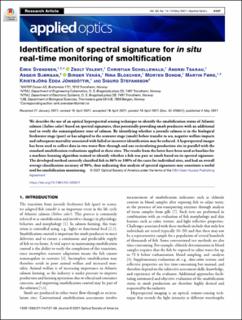Identification of spectral signature for in situ real-time monitoring of smoltification
Svendsen, Eirik; Volent, Zsolt; Schellewald, Christian; Tsarau, Andrei; Bjorgan, Asgeir; Venås, Birger; Bloecher, Nina; Bondø, Morten Steen; Føre, Martin; Jónsdóttir, Kristbjörg Edda; Stefansson, Sigurd Olav
Peer reviewed, Journal article
Published version
Date
2021Metadata
Show full item recordCollections
- Publikasjoner fra CRIStin - SINTEF Ocean [1386]
- SINTEF Ocean [1460]
Abstract
We describe the use of an optical hyperspectral sensing technique to identify the smoltification status of Atlantic salmon (Salmo salar) based on spectral signatures, thus potentially providing smolt producers with an additional tool to verify the osmoregulatory state of salmon. By identifying whether a juvenile salmon is in the biological freshwater stage (parr) or has adapted to the seawater stage (smolt) before transfer to sea, negative welfare impacts and subsequent mortality associated with failed or incorrect identification may be reduced. A hyperspectral imager has been used to collect data in two water flow-through and one recirculating production site in parallel with the standard smoltification evaluations applied at these sites. The results from the latter have been used as baseline for a machine-learning algorithm trained to identify whether a fish was parr or smolt based on its spectral signature. The developed method correctly classified fish in 86% to 100% of the cases for individual sites, and had an overall average classification accuracy of 90%, thus indicating that analysis of spectral signatures may constitute a useful tool for smoltification monitoring.
